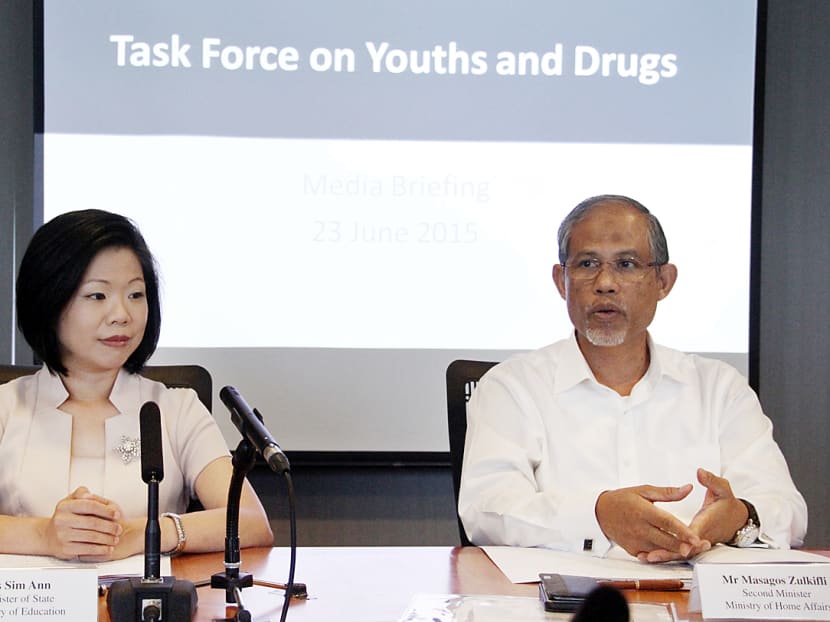Cannabis users buck profile of addicts, see drug as harmless
SINGAPORE — In school, they were students who attended classes diligently and did not have any disciplinary issues. At home, they had good family support and none of their family members had a record of criminal or drug offences, nor did they drink or smoke.

Mr Masagos Zulkifli (right) with Ms Sim Ann from the taskforce on youth and drugs. Photo: Tristan Loh/TODAY
SINGAPORE — In school, they were students who attended classes diligently and did not have any disciplinary issues. At home, they had good family support and none of their family members had a record of criminal or drug offences, nor did they drink or smoke.
Yet they later became users of cannabis, and like many of their peers, believed the use of drugs — especially cannabis — was fine so long as one consumed it in moderation. And social media and celebrities were influences on them to try drugs.
These are among the findings of a study commissioned by the Task Force on Youths and Drugs, conducted from December last year to April. The study comprised a questionnaire, interviews, and focus group discussions involving 700 participants — 237 abusers and 463 non-abusers — aged 12 to 29 years old.
The research team — comprising psychologists from the Home Team — found that the profile of cannabis abusers differed from other young abusers whose drug of choice is typically methamphetamine or “Ice”.
Cannabis abusers came from middle or high socio-economic status households, and were more ethnically diverse — 34 per cent were Chinese and 30 per cent were Malay, compared to “Ice” abusers (24 per cent Chinese and 66 per cent Malay). They also have strong family support and perform well academically.
One study participant, 17, said he was introduced to cannabis by a friend, and sought out more information — like methods of consuming it — over the Internet. He started smoking when he was in Secondary One and believed cannabis was not as harmful as other types of drugs, which made him more open to trying it.
Another participant, 24, who was arrested for cannabis consumption, said he started smoking at age 14, before moving on to cannabis, which he read up about on the Internet. Believing cannabis to be non-addictive, he would seek it out when abroad.
The researchers also found that cannabis users were influenced by social media, with a larger proportion of them citing celebrities as a reason for drug initiation, compared to “Ice” abusers and non-abusers. The rise in the use of social media was also found to have facilitated the dissemination of inaccurate information, with users perceiving that cannabis was less harmful and addictive than tobacco.
Second Minister for Home Affairs Masagos Zulkifli, who co-chairs the taskforce with Minister of State for Education Sim Ann, had in an interview earlier this week flagged the liberal attitudes by youth as a concern. “They think it’s not addictive, it’s not harmful, it is OK to use for recreational use. This is a big shift from what we have had discovered from the past,” he said.
The study noted that many countries in Europe and South America have decriminalised drug use and adopted harm reduction approaches to address overcrowding in prisons and curb human immunodeficiency virus transmissions. In North America, some states has also have legalised cannabis for medical use.
In Singapore, cannabis seizures last year reached 35.03kg – the highest in the past decade, and an increase of 125 per cent from 2013. The number of drug abusers here has increased from 826 in 2010 to 1,100 last year. In 2010, the proportion of new drug abusers who were below 30 years old was about half. Last year, this increased to about two thirds.
To tackle the negative influence of social media and peer groups, the taskforce recommended expanding the use of online platforms and social media to spread anti-drug messages. It also proposed to roll out a rehabilitation programme under the National Addictions Management Services (NAMS) for youths. The CNB will work with NAMS for the programme, which will be for those below 21 years old.
Parents, educators, counsellors and National Service commanders will also be equipped with a toolkit to, for example, help them spot tell-tale signs of drug abuse, and speak with youths about drug issues.
Speaking at the opening ceremony of the anti-drug abuse carnival today (June 26), Mr Masagos, who is also Minister in the Prime Minister’s Office, stressed that Singapore cannot afford to be complacent in the fight against drugs, even though the overall drug situation here remains under control.






